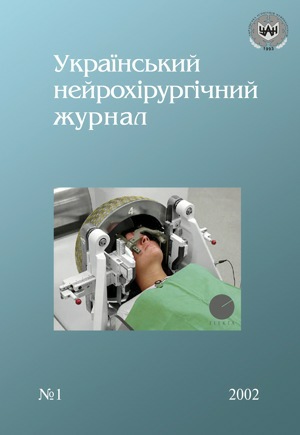Correction of haemostasiologic syndromesfor a treatment of the subarachnoidal hemorrhages at the perioperative period
Keywords:
hemostatic syndrome, hypervolemic hemodilution, arterial aneurysm.Abstract
Two pathological mechanisms are in center of attention for a treatment of the patients with subarachnoidal hemorrhages after a break of arterial aneurysms of a brain: a cerebral vasospasm and ischemia of a brain. We observed a cerebral vasospasm at realization of an angiography and clinically in 60 % of cases at this pathology, in 40 % — the cerebral vasospasm was complicated by an ischemia of a brain, in 7,2 %—13,8 % —15 % of cases resulted in failures. One of the probable reasons of development of an ischemia can be infringement haemorheological and haemostasis of parameters. The parameters adequately reflecting a condition haemocoagulants, fibrinolytic, anticoagulants of systems were investigated at 48 patients with arterial aneurysms in perioperative period. We have compared parities between haemocoagulants, haemostasis in parameters and data neurologic, angiography, tomography and dopplerography of researches. The received results have allowed us to allocate and to describe haemostasiologic polysyndromic variants of current of the postoperative period after clipping of aneurysms: 1. Normocoagulation in 41,7% cases; 2. Hypercoagulation and hyperaggregation in 27 % of cases; 3. Hypercoagulation and deppression of a fibrinolysis — 25%; 4. Hypocoagulation —2,1 %; 5. Development Desseminated intravascular coagulation of a blood — 4,2 of %. These data have allowed us to apply in the postoperative period the following principles of an intensive care: a hypervolemic hemodilution, controlled hypertension, therapy by calcium blockers, fibrinolytic. For treatment and prevention of ischemic complications in the second group of the patients we successfully used a method of a hypervolemic hemodilution.References
Амчеславский Г.В, Тома Г.И., Тенедиева Н.Д. и др. Принципы интенсивной терапии при острых субарахноидальных кровоизлияних нетравматической этиологии// Рос. журн. анестезиологии и интенсивной терапии. — 1999. — №1. — С.77—80.
Верещагин Н.В., Миловидов Ю.К. Современное состояние и перспективы развития ангионеврологии.—М., 1988. — С.19—20.
Ганнушкина И.В. Патофизиологические механизмы нарушений мозгового кровообращения и новые направления в их профилактике и лечении//Журн. неврологии и психиатрии им. С.С. Корсакова. — 1996. — №1. — С.14—17.
Гелб А.В., Ватт А. Анестезиологическое обеспечение у больных с церебральными артериальными аневризмами// Рос. журн. анестезиологии и интенсивной терапии. — 1999. — №1. — С.33—38
Грушевский В.Е. Номограмма для оценки волемии по клиническим признакам// Анестезиология и реанимация. — 1989. — С.24—27.
Иванов Е.П. Диагностика нарушений гомеостаза. — Беларусь, 1983.
Лемаршан Э., Жерар Ж.-Л., Брикар А. Тактика ведения мозгового кровообращения// Рос. журн. анестезиологии и интенсивной терапии. — 1999. — №1. — С.83—91.
Меньшиков В.В. Лабораторные методы исследования в клинике. — М., 1987. — С.149—172.
Метелицина И.П., Левицкая Г.В., Гриненко Т.В. Методы исследования системы фибринолиза и её компонентов// Укр. биохим. журн. — 1997. — Т.68, №5—6. — С.32—40.
Платонова Т.М., Чернишенко Т.М., Горницкая О.В. Комплексная лабораторная диагностика нарушений системы гемостаза при диссеминированном внутрисосудистом свертывании крови. — Лаб. диагностика. — 2000. — №3. — С.3—11.
Попов В.В., Молчанов И.П., Карпуничев О.Б. и др. Базовая терапия ишемического церебрального инсульта: Метод терапевтической гемодилюции //Анестезиология и реаниматология . — 2000. — №4. — С.44—48.
Сон А.С. Хирургическое лечение, показания к нему и причины смертности в остром периоде разрыва артериальных аневризм головного мозга// Бюл. УАН. — 1998. — №4. —С.60—63.
Титова Г.П., Крылов В.В., Негрецкий А.П. и др. Роль ишемического инфаркта мозга в развитии летальных исходов при разрыве внутричерепных артериальных аневризм. //Арх. патологии. — 1995. — №2. — С.25—29.
Царенко С.В., Крылов В.В., Вахницкая В.В., Тимченко Н.П. Интенсивная терапия внутричерепных аневризм// Материалы VI Междунар. симпоз., Россия, Санкт-Петербург, 19—21 мая 2001 г. — С.490—492.
Kassel N.F.The International Cooperative Study on the Timing of Aneurism Surgery: Part 1. Overall management results// J. Neurosurg. — 1990 — V.73. — P.18—36.
Downloads
How to Cite
Issue
Section
License
Copyright (c) 2002 O. A. Tsimejko, L. I. Romanenko, A. A. Ivaschina, A. I. Aldarf

This work is licensed under a Creative Commons Attribution 4.0 International License.
Ukrainian Neurosurgical Journal abides by the CREATIVE COMMONS copyright rights and permissions for open access journals.
Authors, who are published in this Journal, agree to the following conditions:
1. The authors reserve the right to authorship of the work and pass the first publication right of this work to the Journal under the terms of Creative Commons Attribution License, which allows others to freely distribute the published research with the obligatory reference to the authors of the original work and the first publication of the work in this Journal.
2. The authors have the right to conclude separate supplement agreements that relate to non-exclusive work distribution in the form of which it has been published by the Journal (for example, to upload the work to the online storage of the Journal or publish it as part of a monograph), provided that the reference to the first publication of the work in this Journal is included.









